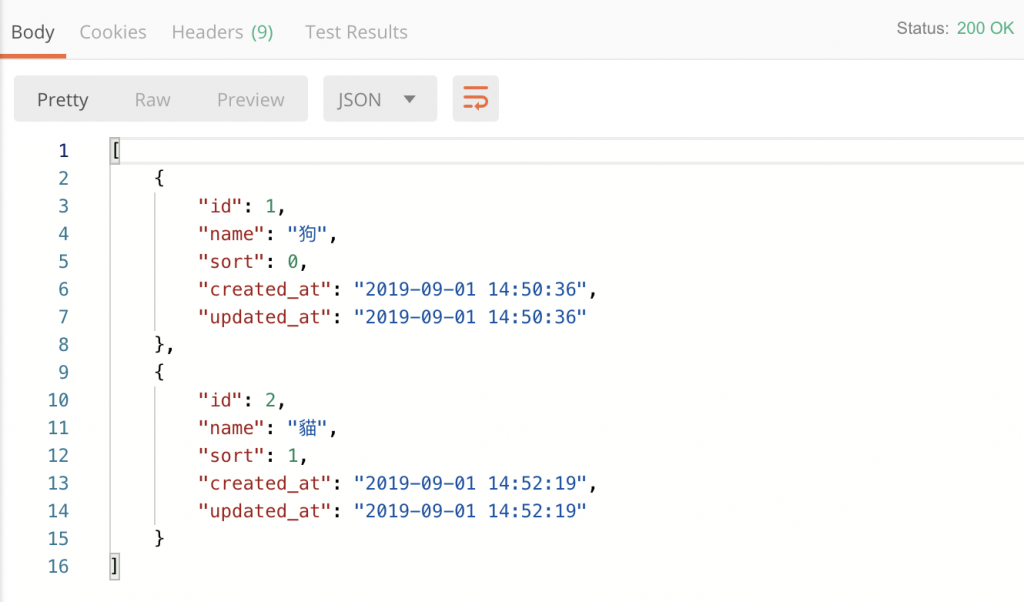本系列文章已集結成冊與鐵人賽文章差異內容,有以下幾點:
更新至Laravel 8、基礎的PHP重點筆記、加強製作API流程細節、加入程式設計模式,優化、重構程式碼的部分,並且於書籍前面的章節介紹Git。
讓您從製作第一個簡單的API到優化自己的程式碼,分享我的經驗給您,打造自己的最強大腦API,若有興趣的朋友可以參考看看
此篇文章同步發於個人部落格
類別 type,預計紀錄該系統的動物分類 (貓、狗、其他...)
定義一個資源需要有哪些詳細資料。
| 欄位名 | 說明 | 格式 | 備註 |
|---|---|---|---|
| id | 分類id | int(10) unsigned | |
| name | 類別名稱 | varchar(50) | |
| sort | 排序 | int(10) | |
| created_at | 新建時間 | timestamp NULL | |
| updated_at | 更新時間 | timestamp NULL |
C:\project\animal\ > php artisan make:model Type -rmc

來到 api.php 把路由指定到 TypeController
Route::apiResource('types', 'TypeController');
animal/database/migrations/2019_08_30_213108_create_types_table.php 檔名的時間會是你產生檔案時的時間
<?php
use Illuminate\Support\Facades\Schema;
use Illuminate\Database\Schema\Blueprint;
use Illuminate\Database\Migrations\Migration;
class CreateTypesTable extends Migration
{
/**
* Run the migrations.
*
* @return void
*/
public function up()
{
Schema::create('types', function (Blueprint $table) {
$table->bigIncrements('id');
$table->string('name')->unique()->comment('類別名稱');
$table->integer('sort')->default(100)->comment('排序');
$table->timestamps();
});
}
/**
* Reverse the migrations.
*
* @return void
*/
public function down()
{
Schema::dropIfExists('types');
}
}
資料庫外鍵約束關聯的部分會再後面優化的時候加入!
TypeController
<?php
namespace App\Http\Controllers;
use App\Type;
use Illuminate\Http\Request;
use Symfony\Component\HttpFoundation\Response;
class TypeController extends Controller
{
/**
* Display a listing of the resource.
*
* @return \Illuminate\Http\Response
*/
public function index()
{
$types = Type::get();
return response($types, Response::HTTP_OK);
}
/**
* Store a newly created resource in storage.
*
* @param \Illuminate\Http\Request $request
* @return \Illuminate\Http\Response
*/
public function store(Request $request)
{
$this->validate($request, [
'name' => 'required|max:50|unique:types,name',
'sort' => 'nullable|integer',
]);
if (empty($request->sort)) {
$max = Type::get()->max('sort');
$request['sort'] = $max+1;
}
$type = Type::create($request->all());
return response($type, Response::HTTP_CREATED);
}
/**
* Display the specified resource.
*
* @param \App\Type $type
* @return \Illuminate\Http\Response
*/
public function show(Type $type)
{
return response($type, Response::HTTP_OK);
}
/**
* Update the specified resource in storage.
*
* @param \Illuminate\Http\Request $request
* @param \App\Type $type
* @return \Illuminate\Http\Response
*/
public function update(Request $request, Type $type)
{
$type->update($request->all());
return response($type, Response::HTTP_OK);
}
/**
* Remove the specified resource from storage.
*
* @param \App\Type $type
* @return \Illuminate\Http\Response
*/
public function destroy(Type $type)
{
$type->delete();
return response(null, Response::HTTP_NO_CONTENT);
}
}
雖然我們在資料庫的部分,沒有做關聯,但在撰寫Model時可以先建立好模型關聯。方便用簡潔的方式取的關聯資料。例如:
查詢「狗」種類中的所有動物 (假設狗的類別 ID 是 1 )
$animals = Type::find('1')->animals;
或者反過來查詢這個動物是什麼種類。(如下語法可以讀取動物同時並帶出關聯類別)
$animal = Animal::with('type')->find('1');
很常聽到的 MVC架構 , M 就是Model,每個資料表都有一個對應的Model用來與該資料表互動。
Model有點像中間人的概念,只要告訴Model這個人就能新增、刪除、修改、查詢資料表。
Laravel 的Eloquent ORM 提供簡潔的 Active Record 模式來實作與資料庫的互動。
特點就是剛剛所說的一個 Model 對應關聯型資料庫中的一個表,而 Model 的一個實體對應資料表中的一行記錄。
可以輕鬆儲存物件的特性與關係,取出來的時候也不需要撰寫 SQL 語句,總體上減少了與資料庫存取有關的程式碼。
animal/app/Type.php
<?php
namespace App;
use Illuminate\Database\Eloquent\Model;
class Type extends Model
{
/**
* 可以被批量賦值的屬性。
*
* @var array
*/
protected $fillable = [
'name',
'sort'
];
/**
* 取得類別的動物
*/
public function animals()
{
return $this->hasMany('App\Animal', 'type_id', 'id');
}
}
Animal 的 Model 也要加上反向的關聯,這樣就可以從Animal這個方向去查詢type,主要是下方的 type 方法
animal/app/Animal.php
<?php
namespace App;
use Illuminate\Database\Eloquent\Model;
class Animal extends Model
{
/**
* 可以被批量賦值的屬性。
*
* @var array
*/
protected $fillable = [
'type_id',
'name',
'birthday',
'area',
'fix',
'description',
'personality',
];
/**
* 取得動物的分類
*/
public function type()
{
return $this->belongsTo('App\Type');
}
}
測試之前記得先跑 php artisan migrate指令。
資料庫讓它新建 types 資料表。






注意以上狀態碼,以及回傳的內容,如果有錯誤嘗試看看哪裡有打錯字或是少引入檔案,上面的程式碼也是我不斷地發生錯誤訊息,修正後才完成的!加油~
